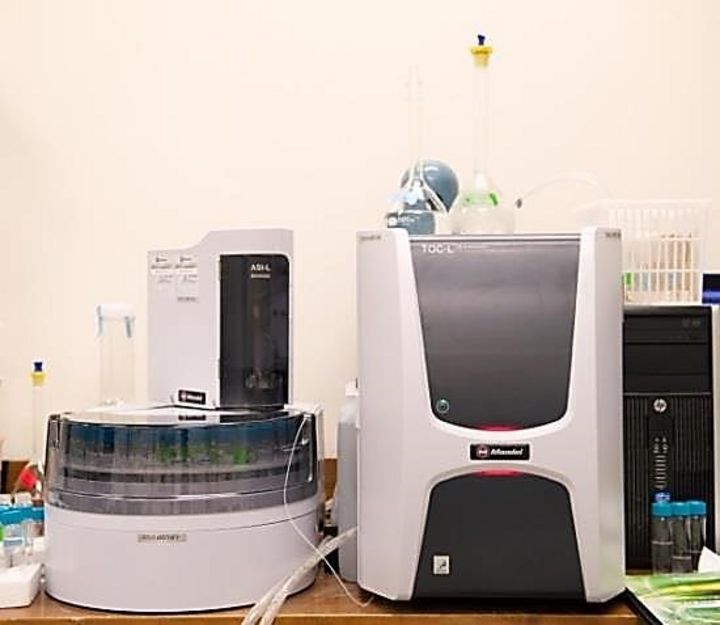
- Atomic absorption spectrophotometer (flame and graphite furnace)
- Automated titrator and Karl Fisher
- Capillary electrophoresis
- Differential Scanning Calorimeter (DSC)
- Fluorescence Spectrometer X (XRF)
- FTIR infrared spectrometer with cell specialized in gas and biogas analysis
- Fluorimeter
- Gas chromatograph (GC-TCD) for gas analysis
- Gas chromatograph (GC-FID)
- FTIR Infra-Red Spectrometer For Solid And Liquid Samples
- Ion chromatography
- Gas chromatograph combined with a mass spectrometer (GC-MS)
- High-performance liquid chromatography combined with an ion-trap mass spectrometry (LC-MS)
- High-Performance Liquid Chromatography (2 Units, One Of Which Is Equipped With A Fraction Collector)
- High-Performance Liquid Chromatograph With An ELSD Detector (Electrospray Light Scattering Detector)
- Kjeldahl analyzer (total nitrogen and ammonia)
- Spectromètre d’émission optique muni d’un plasma à couplage inductif (ICP-OES)
- Thermogravimetric analyzer coupled with mass spectrometer (TGA-MS)
- Total organic carbon analyzer
The Aquatic Bio-optics and Biogeochemistry Laboratory enables researchers to study the effects of climate change and permafrost thawing on lake water transparency and mixing dynamics and their multiple impacts on the microbial food chain, greenhouse gas emissions, and oxythermal habitat. Research at the Aquatic Bio-Optics and Biogeochemistry Laboratory also focuses on developing optical equipment for early detection of algal and cyanobacterial blooms and other problems related to water browning.

/// Description :
- A 55 L / min, 15 psig capacity coalescing separation vessel, SS316 stainless steel and acrylic construction with internal support for TORR ™ coalescing cartridge and safety valve
- A centrifugal type electric water pump, 220 VAC, 15 amp
- A 200-liter plastic back-up tank with removable cover for storing and recirculating water
- Set of 1 '' industrial piping, flexible for interconnection of the various elements of the system
- Set of valves for component isolation and for pump flow control
- Pressure gauges at the entry and exit of the vessel
- A 48 '' x 48 '' stainless steel table with retention walls in the event of a system leak on which all system components rest
- 10 sealing washers for replacement
- Made and assembled in Quebec
- Works with TORR ™ coalescing cartridges. Model TC-008-2, 6 '' diam x 20 '' high, nylon and nitrile gaskets
Confocal microscopy and flow cytometry laboratoryThe laboratory is equipped with a four-laser LSRFortessa cytometer that allows high-level multiparametric analyzes to characterize cell populations. A BD FACS Calibur two-laser cytometer is used to perform routine analyzes such as the expression of surface markers. The Zeiss LSM780 confocal microscopy system is a state-of-the-art instrument for the study of various cellular and subcellular biological processes such as intracellular trafficking and localization of pathogen molecules.
This pilot laboratory provides the scientific community and industry with its multidisciplinary expertise and state-of-the-art equipment for the development and scaling of fermentation processes as well as the recovery, purification and characterization of various microbial derivatives. Its primary purpose is R & D in the field of biotechnology, and especially value-added products using putrescible residues as raw material.
The main objective of this project is to evaluate different final cover scenarios to reduce the production of leachate in a Saint-Nicéphore landfill, located in Drummondville, Quebec. In order to assess the percolation, the Université de Sherbrooke team proposed to build an experimental plan on the existing coverage of the site. Five lysimeters were built in 4 enclosures, that is to say areas where all the runoff water is collected in order to monitor their quantity and quality over time. The quality must be monitored due to the presence of contaminated soil in some of the scenarios under study, while the quantities are used to carry out water balances over time. This project is done in collaboration with the company Waste Management and receives financial support from WM, CRSNG and CRIBIQ.
/// Features:
- Processing volume: 1 to 4 L
- Operating pressure up to 600 psi
- Feed flow ranging from 1 L/min to 6 L/min
- Membrane coupons for MF, UF, NF, and OI
- Can be adapted to forward osmosis
/// Samples:
- Liquids: effluents, residual liquids, process waters, fluids, etc.
/// Examples of applications
- Scanning and selection of the type of membrane to be used
- Optimization of membrane filtration parameters: flow, pressure, temperature
- Studies of the effects on liquids and membranes (precipitations, clogging, pressure drop, etc.)
/// Features:
- Enables the simultaneous testing of several flocculation / pre-filtration conditions
The purpose of the BEREV is to characterize the water cycle and the surface flows (energy, water and carbon) in a boreal environment in order to increase our understanding of the hydrological and hydrometeorological processes in the presence of abundant snow, in support of a better modeling and better forestry practices. In particular, BEREV has micrometeorological equipment above the canopy. To know more, watch this webinar about the BEREV: https://youtu.be/-bbwMuuYLYg
/// Examples of applications:
- Separating and concentrating metal nanoparticles